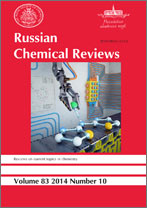|
This article is cited in 40 scientific papers (total in 40 papers)
Relativistic pseudopotential model for superheavy elements: applications to chemistry of eka-Hg and eka-Pb
A. V. Zaitsevskiia, Ch. van Wüllenb, A. V. Titovc
a Institute of Hydrogen Energetics and Plasma Technologies, Russian Research Centre "Kurchatov Institute"
b Technical University of Kaiserslautern
c B. P. Konstantinov Petersburg Nuclear Physics Institute, Russian Academy of Sciences
Abstract:
Relativistic pseudopotential approach to the electronic structure simulation of superheavy elements (SHE) compounds is presented. Advanced formulations of this approach leaving both valence and outer-core electronic shells for explicit treatment give rise to simple and efficient computational techniques ensuring highly accurate description of most chemical properties of SHE. At present, the errors due to the use of approximate methods for solving the correlation problem for a subsystem of valence electrons are much larger than those stemming from the pseudopotential approximation itself. Recent applications to the studies of the chemistry of elements 112 (eka-Hg) and 114 (eka-Pb) are reviewed; properties of these elements and their lighter homologues, Hg and Pb, are compared.
Received: 13.05.2009
Citation:
A. V. Zaitsevskii, Ch. van Wüllen, A. V. Titov, “Relativistic pseudopotential model for superheavy elements: applications to chemistry of eka-Hg and eka-Pb”, Usp. Khim., 78:12 (2009), 1263–1272; Russian Chem. Reviews, 78:12 (2009), 1173–1181
Linking options:
https://www.mathnet.ru/eng/rcr204https://doi.org/10.1070/RC2009v078n12ABEH004075 https://www.mathnet.ru/eng/rcr/v78/i12/p1263
|


| Statistics & downloads: |
| Abstract page: | 488 |
|





 Contact us:
Contact us: Terms of Use
Terms of Use
 Registration to the website
Registration to the website Logotypes
Logotypes








